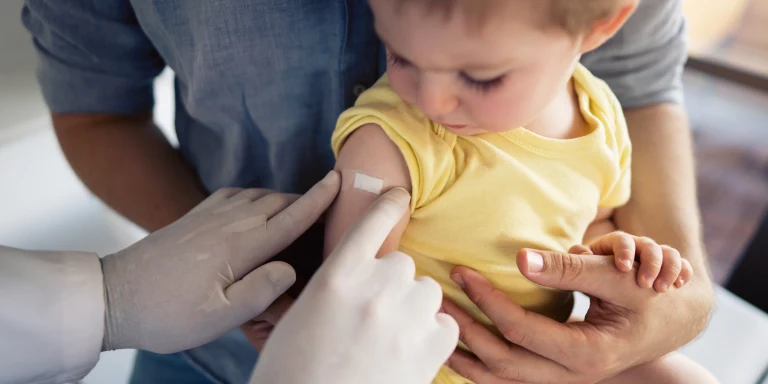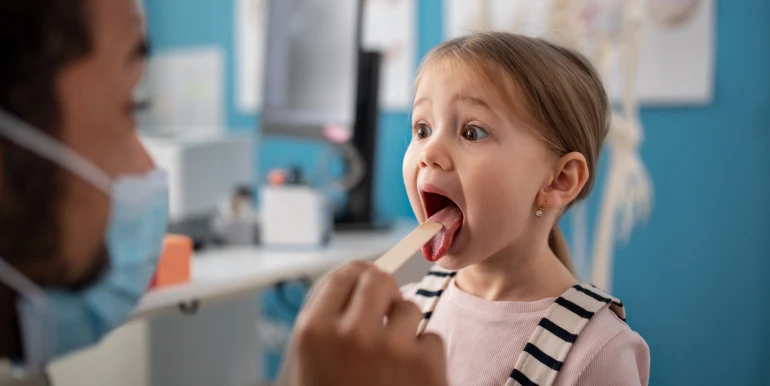
MMR vaccination: when should you have it?
Measles, mumps and rubella are highly infectious diseases. In Switzerland, a triple vaccine is available to protect children, but is the MMR vaccination helpful? We provide the information so you can make up your mind.
MMR-Impfung – was ist das?
The MMR vaccination protects against measles, mumps and rubella – three highly contagious childhood illnesses. Different viruses cause these illnesses. They are spread mainly via the air through sneezing, talking and coughing, getting transmitted from one person to the next. The likelihood that illness will spread depends on how many people have the MMR vaccination; the more people vaccinated, the less the viruses can spread.
There is no medical cure for the childhood illnesses measles, mumps and rubella. These illnesses can be severe and may lead to complications, for example during pregnancy, as well as other situations. So it makes all the more sense to vaccinate your child against them.
In addition to the MMR vaccination, the MMRV vaccination (measles, mumps, rubella and varicella vaccination) has been available since January 2023. This additionally protects against chickenpox.
MMR vaccination ingredients
The key ingredients of the measles, mumps, rubella and varicella vaccine are weakened viral strains of the pathogens. That is why experts refer to the MMR vaccine as a live vaccine. The body forms antibodies in response to live vaccines. These immunise the person against the diseases. Neither the MMR nor MMRV vaccination contains aluminium or mercury. The vaccine is regarded as highly effective and safe.
MMR vaccination: when should you vaccinate and how often?
The Swiss Federal Office of Public Health (FOPH) MMR vaccination plan recommends the MMR vaccination for babies at age 9 months and the second dose at 12 months. Under certain circumstances, medical experts may advise the MMR vaccination for your baby at 6 months of age if your child is thought to be at higher risk of developing one of the illnesses. In that case, the FOPH recommends three doses of the MMR vaccination. Here the first dose would be between 6 and 8 months of age, the second at 9 months and the third and final dose at 12 months. Once you’ve had the full MMR vaccination, you don’t need a booster. It provides lifelong protection. The same applies to the MMRV vaccination.
Watch the video to learn more about measles, mumps and rubella and also about the scientific findings on the MMR vaccination (see also “Studies”).
Conclusion from the video: from a medical point of view, the MMR vaccination is of considerable benefit, since measles, mumps and rubella are highly contagious and the consequences can be particularly severe for pregnant women.
The MMR vaccination is recommended for babies and children and also for adults. If you are not vaccinated and you were born after 1963, you should take advantage of the measles, mumps and rubella vaccination as well. If you are planning to get pregnant, vaccination against MMR is particularly important. You will avoid complications related to measles, mumps and rubella for yourself and for your baby. Rubella, for example, can be passed on to your unborn child and cause severe harm or even death. Both measles and mumps can also increase the risk of premature birth or stillbirth.
After an MMR vaccination, adults can have mild reactions similar to those experienced by babies and children: redness or swelling at the injection point, fever, headaches or a skin rash. Adults sometimes temporarily experience aching in their joints.
Which are the possible reactions after an MMR vaccination?
Mild reactions following an MMR vaccination are normal. They are a sign that the body is tackling the viruses. Any symptoms will disappear completely after a few days. Typical vaccination reactions include redness, pain or swelling at the point of injection. Severe side effects are extremely rare (less than 1 per million).
- Fever after MMR vaccination: Around one in ten children will develop a fever. This usually occurs 7 to 12 days after the vaccination and subsides after 1 to 2 days. A very high fever can lead to febrile convulsions in small children, so it is important to monitor the child’s temperature. When should you consult a doctor? If your child has a fever of 38.5°C, give them medication to bring the fever down. This prevents febrile convulsions. If the fever after the MMR vaccination reaches 40°C, consult your paediatrician.
- MMR vaccination and skin rash: Around 14 days after the MMR vaccination a rash may appear on the skin. These “vaccine-induced measles” are harmless and disappear on their own after a few days. They are also not contagious.
- Swollen salivary gland: After the vaccination, there may be slight swelling in the parotid gland (a gland that produces saliva).
- Fewer blood platelets: In fewer than one in 1,000 cases, vaccination can lead to a temporary drop in platelets, which help blood to clot. Children who experience this reaction will bleed more easily.
Good to know: After the second MMR vaccination, side effects rarely occur. The MMR vaccination does not strain the immune system or heighten the risk of contracting disorders such as autism, inflammatory or autoimmune diseases or allergies.
Do you have any questions about this or other vaccination issues? Talk to your doctor. You can also use the dedicated vaccination information platform Infovac.ch.
MMR vaccination: studies on effectiveness
The Harding Center for Risk Literacy at the University of Potsdam has summarised the benefits and risks of the MMR vaccination. You’ll also find these in our video. Researchers found the following:
- If 1,000 unvaccinated children and adolescents came into contact with the measles virus, approximately 931 of them would contract measles. For every 1,000 children and adolescents vaccinated, 14 would become ill.
- If 1,000 unvaccinated children and adolescents came into contact with the mumps virus, approximately 360 of them would contract mumps. For every 1,000 children and adolescents vaccinated, 50 would become ill.
- If 1,000 unvaccinated children and adolescents came into contact with the rubella virus, approximately 500 of them would contract rubella. For every 1,000 children and adolescents vaccinated, 35 would become ill. Embryos and unborn children of mothers who are not vaccinated against rubella and contract the disease have a much higher risk of harm.
Protect yourself and your child from measles, mumps and rubella. You can get more information about the MMR vaccination from your paediatrician. The doctor will explain the procedure, risks and contraindications – in other words, the cases where the MMR vaccination is not a good idea.

The expert provided the editorial team with expert advice and input for this article. Simeon Zürcher (PhD in Epidemiology and Biostatistics) works as a researcher in the Public Health Sciences team at Helsana.


Newsletter
Find out more about current health issues every month and get all the information you need about our attractive offers from all Helsana Group companies * delivered by e-mail to read whenever it suits you. Our newsletter is free of charge and you can sign up here:
We did not receive your information. Please try again later.
* The Helsana Group comprises Helsana Insurance Company Ltd, Helsana Supplementary Insurances Ltd and Helsana Accidents Ltd.